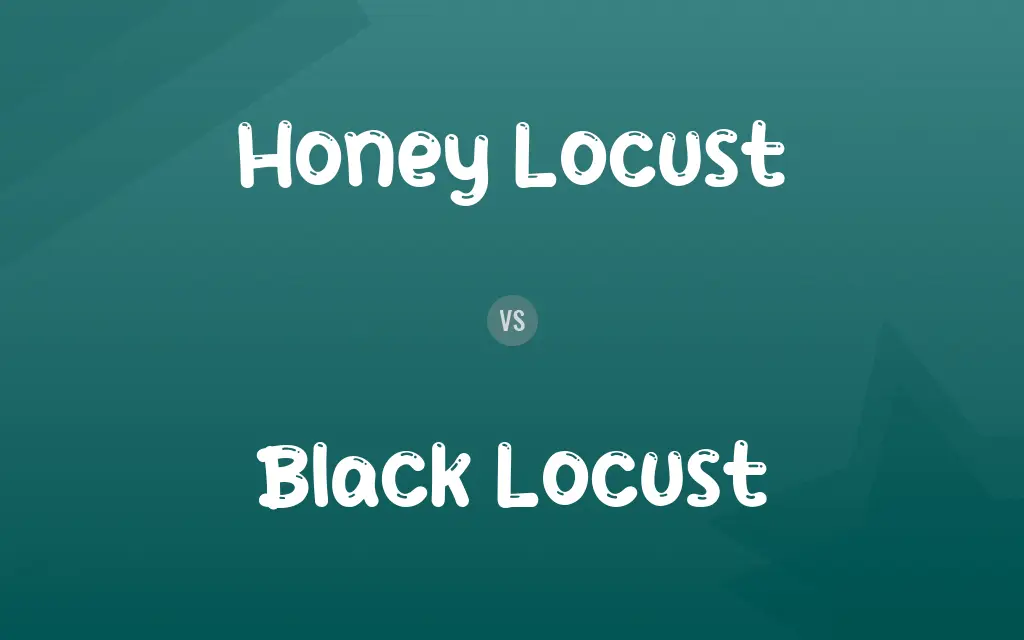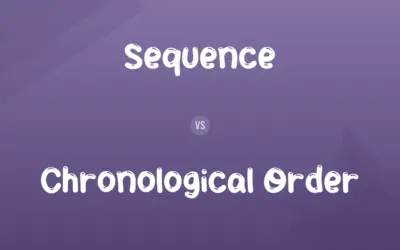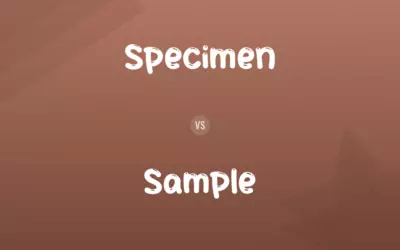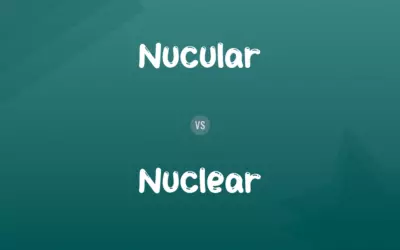Honey Locust vs. Black Locust: Difference and Comparison
Edited by Muazma Batool — By Muneeza Rehman — Published on March 22, 2024
Honey locust trees are known for their open canopy and small, fern-like leaves, producing long, twisted pods. Black locust trees feature a denser canopy with larger leaflets and are renowned for their fragrant, white flower clusters.

Difference Between Honey Locust and Black Locust
Honey locust trees (Gleditsia triacanthos) are recognizable by their open, spreading canopy and small, delicate, fern-like leaves, allowing sunlight to filter through easily. This characteristic makes them popular in landscapes desiring light shade. Black locust trees (Robinia pseudoacacia), however, have a denser canopy with larger, oval-shaped leaflets, providing more substantial shade and are known for their beautiful, fragrant clusters of white flowers that bloom in late spring.
Muneeza Rehman
Mar 22, 2024
The honey locust is often chosen for urban environments because of its tolerance to pollution and poor soil conditions, along with its distinctive long, twisted seed pods that can grow up to 18 inches long. Black locust, on the other hand, is valued for its hard, durable wood and shorter, straight seed pods, which are typically 4-5 inches long. Both species are part of the Fabaceae family, indicating their ability to fix nitrogen in the soil, which can improve soil health.
Muneeza Rehman
Mar 22, 2024
Honey locusts can be identified by their thorns, which can be quite long and are often found on the trunk and branches, although thornless cultivars are popular in landscaping. Black locust trees also have thorns, but these are usually shorter and located at the base of each leaf. The presence of thorns in both species can be a deterrent for wildlife and humans, but it also adds to the trees' character and protective qualities.
Muneeza Rehman
Mar 22, 2024
Both trees are resilient and adaptable to a variety of conditions, honey locusts prefer more moist, well-drained soils and are more tolerant of saline conditions, making them suitable for a broader range of landscapes. Black locusts are exceptionally hardy, with a preference for well-drained, slightly acidic to neutral soils, and are often used for erosion control due to their rapid growth and robust root systems.
Elijah
Mar 22, 2024
Despite their similarities, the trees serve different ecological and landscaping purposes. Honey locusts are often used for ornamental purposes due to their unique foliage and pod characteristics, whereas black locusts are highly valued for their wood, which is resistant to rot and used in furniture, flooring, and fence posts. Both, however, contribute positively to the environment by enhancing soil fertility through nitrogen fixation.
Muneeza Rehman
Mar 22, 2024
Honey Locust vs. Black Locust Comparison Chart
Soil Preference
Tolerant of various types, including saline conditions
Prefers well-drained, slightly acidic to neutral soils
Muneeza Rehman
Mar 22, 2024
Use in Landscaping
Ornamental, light shade
Erosion control, ornamental, wood production
Kaitlyn
Mar 22, 2024
Honey Locust vs. Black Locust Definitions
◉Honey Locust
Has thornless varieties popular in landscaping.
We chose a thornless honey locust for the schoolyard to ensure safety for the children.
Elijah
Feb 27, 2024
◉Black Locust
A tree valued for its durable wood and fragrant flowers.
The black locust’s white flowers fill the spring air with their sweet fragrance.
Muneeza Rehman
Feb 27, 2024
◉Honey Locust
A tree known for its open canopy and fern-like leaves.
The honey locust in our yard provides the perfect amount of shade for the underplantings to thrive.
Muneeza Rehman
Feb 27, 2024
◉Black Locust
Its wood is resistant to rot and highly prized.
For outdoor furniture, black locust wood is the top choice due to its durability.
Jonathan
Feb 27, 2024
◉Honey Locust
Produces long, twisted seed pods.
In the fall, the ground beneath the honey locust is littered with its characteristic twisted pods.
Muneeza Rehman
Feb 27, 2024
◉Black Locust
Known for rapid growth and robust root system.
Planted to control erosion, the black locust quickly stabilized the hillside.
Henry
Feb 27, 2024
◉Honey Locust
Tolerant of pollution and poor soil.
Even in the compacted soil of the urban park, the honey locust trees flourish.
Muneeza Rehman
Feb 27, 2024
◉Black Locust
Features a dense canopy with larger leaves.
The dense canopy of the black locust offers ample shade in our backyard.
Muneeza Rehman
Feb 27, 2024
◉Honey Locust
Provides light, dappled shade.
Under the honey locust, delicate shade-tolerant flowers bloom abundantly.
Levi
Feb 27, 2024
◉Black Locust
Produces short, straight seed pods.
The black locust seed pods are a favorite foraging item for local wildlife.
Muneeza Rehman
Feb 27, 2024
Honey Locust vs. Black Locust Frequently Asked Questions
What are the main uses of honey locust trees?
They are primarily used for ornamental purposes and providing light shade in landscapes.
Henry
Mar 22, 2024
Are honey locust trees good for urban areas?
Yes, their tolerance to pollution and poor soil makes them suitable for urban landscaping.
Muneeza Rehman
Mar 22, 2024
Why is black locust wood so valued?
Its high durability and resistance to rot make it ideal for outdoor uses like furniture and fence posts.
Muneeza Rehman
Mar 22, 2024
What kind of maintenance do honey locust trees require?
Honey locusts are low-maintenance but may need cleanup of fallen pods in residential areas.
Muneeza Rehman
Mar 22, 2024
What distinguishes honey locust from black locust trees?
Honey locusts are known for their open canopy and twisted seed pods, whereas black locusts are recognized for their dense canopy and fragrant white flowers.
Muneeza Rehman
Mar 22, 2024
How long do honey locust and black locust trees live?
Both can live several decades, with black locusts often living over 100 years in favorable conditions.
William
Mar 22, 2024
Can both honey locust and black locust fix nitrogen in the soil?
Yes, both species improve soil health by fixing nitrogen.
Muneeza Rehman
Mar 22, 2024
Are black locust trees invasive?
In some regions, black locust can be considered invasive due to its rapid growth and spreading capability.
Kaitlyn
Mar 22, 2024
How do honey locust and black locust trees benefit the environment?
Besides improving soil fertility, they provide habitat and food for wildlife.
Levi
Mar 22, 2024
Do honey locust trees produce flowers?
Yes, but they are less conspicuous compared to the showy blooms of black locust.
Lucas
Mar 22, 2024
Content Creators
Written by
Muneeza RehmanAt Comparisons.wiki, Muneeza skillfully navigates the vast sea of information, ensuring clarity and accuracy as the lead content editor. With a keen eye for detail, she curates every comparison to enlighten and engage readers.
Edited by
Muazma BatoolAs a content editor, Muazma Batool is not just a grammar guru but a creative mastermind who breathes life into every word. With an eagle eye for detail and a passion for storytelling, she transforms bland text into engaging content that captivates audiences and drives results.





























